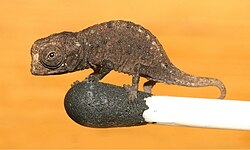| Brookesia micra | |
|---|---|
 | |
 | |
| Adult female in natural habitat (top), juvenile on match head (bottom) | |
| Scientific classification | |
| Kingdom: | Animalia |
| Phylum: | Chordata |
| Class: | Reptilia |
| Order: | Squamata |
| Suborder: | Iguania |
| Family: | Chamaeleonidae |
| Genus: | Brookesia |
| Species: | B. micra |
| Binomial name | |
| Brookesia micra | |
 | |
Brookesia micra, also known as the Nosy Hara leaf chameleon is a species of chameleons from the islet of Nosy Hara in Antsiranana, Madagascar. [1] At the time of its discovery, it was the smallest known chameleon and among the smallest reptiles, until the 2021 discovery of the even smaller B. nana . Adult B. micra can grow up to 29 mm (1.1 in) in length. [2]
